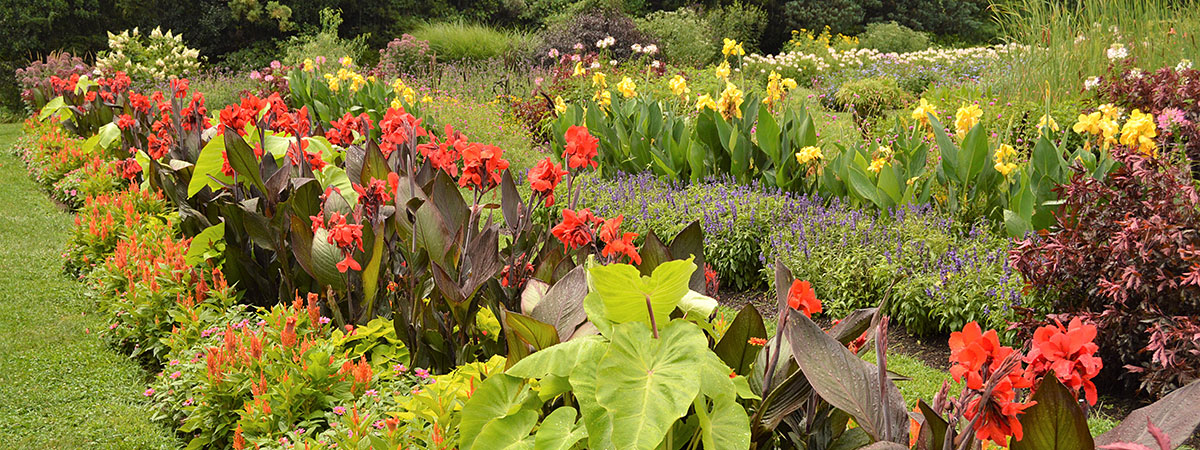
One of Rutgers Gardens most known and sought-out locations, this garden area is named for the Extension Specialist in Home Horticulture—Mr. Donald B. Lacey—who, in 1964, oversaw the conversion of a massive display of bearded iris into a demonstration garden of annuals that are suitable for the home landscape. Over the intervening decades, this garden has grown into one of the finest displays of unusual and colorful annuals, tropicals, herbs, and vegetables that can be visited in the state of New Jersey. Shutterbugs are often found snapping photos of the beautiful flowers and butterflies, while permit-wielding photographers usher newlyweds and prom-goers to the colorful locale.
Visitors are awestruck by the dizzying array of colors and textures found in this garden’s beds and containers. Designed annually by Rutgers Gardens staff Horticulturist, Monica McLaughlin, the garden is dutifully planted and maintained by her, with the help of volunteers and interns. The garden is arranged in an attractive formal pattern of concentric squares around a central pond. Although the planting design of the garden changes every year, there are many favorites that you are likely to see planted, such as Verbena bonariensis, Flowering Tobacco (Nicotiana sylvestris), and various types of Salvia, Globe Amaranth (Gomphrena), and Coleus. It is a place to showcase exciting new colors and varieties of annuals like Petunia, Impatiens, Zinnia, Cleome, Celosia, Begonia, and Angelonia. But we also plant stunning tropicals—like Lantana, Canna, and ‘Mahogany Splendor’ Hibiscus—which are only hardy in warmer zones, but add wonderful, exotic colors when treated as annuals. You will also discover unexpected components that lend a unique element to the plantings, such as Ornamental Peppers, Millet, and Eucalyptus. Each year holds new, exciting plants and themes.
Three perennial borders frame this display of annuals. The sides, dubbed the “chroma beds,” were initially designed by a student in the Landscape Architecture Department, these beds focus on color, and feature concentrated hues of red, blue, yellow, and purple. Updated since their original planting, these borders are ever-changing through the gardening season. The chroma beds include grasses, cut backs (woody plants that are cut back heavily each spring), and a variety of perennials. The yellow bed includes intriguing plants like the ‘Flying Dragon’ Poncirus and the ever-popular popcorn plant, Senna didymobotrya. The blue bed is punctuated in spring by eye-catching Blue Star (Amsonia hubrichtii) and in late fall by Aster tataricus ‘Jindai’, which provides a much-needed food source for pollinators, who love it as much as we do. The star of the red bed is the Hibiscus moschatus, with its enormous flowers, while the purple chroma bed features a sea of Plumbago (Ceratostigma plumbaginoides) and gorgeous specimens such as the tall, native New York Ironweed (Vernonia novaboracensis).
Along the front is a mixed border that was designed by an adult education class offered at Rutgers Gardens. This bed also includes shrubs, perennials and grasses, but focuses on plants that provide a greatly extended season of interest in regards to flowering, texture or foliage coloration. Flanked by beautiful ‘Natchez’ Crape Myrtles (Lagerstroemia) at either end, which provide white flowers in summer and bright exfoliating bark throughout the year, the centers of the beds are anchored by the deep burgundy of the ‘Summer Wine’ Ninebarks (Physocarpus opulifolius), which compliment nicely the pink flowers of the Indigofera.
To help cure your winter blues, visit in late April-early May to see the spring bulb display of 14,000 Grape Hyacinth (Muscari species), Narcissus, and Crown Imperial (Fritillaria imperialis). Replanted each year, these plants were selected not only for their beauty, but for their deer resistance, as well. With the Coral Bark Willow, Corkscrew Willow, Poncirus, and Crape Myrtles contributing winter interest, there is truly something to appreciate in every season.


